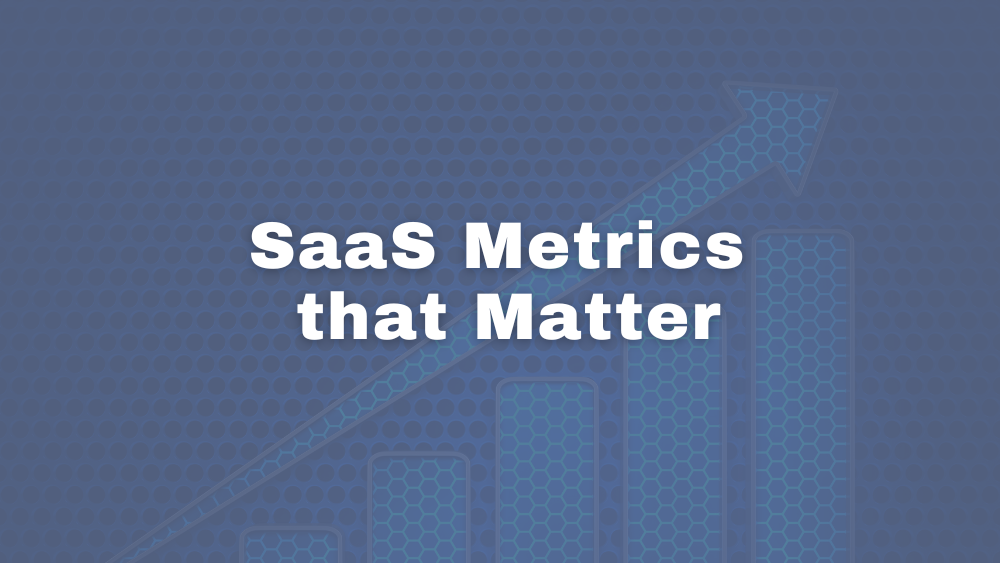SaaS Metrics: Learn Most Important Metrics to Track

SaaS Metrics: Learn Most Important Metrics to Track
One piece of the financial core triad is your SaaS metrics. Clayton Whitfield from SaaSOptics explains which SaaS metrics to track and when.
Every business is different, and everybody has their favorite metrics that they want to focus on at different times. But some SaaS metrics make more sense based on the level of maturity of your business.
Product/ Market Fit
Product/Market Fit is what you’re all about in the early days, trying to make sure you’ve got a product people will pay for and you’re hitting a mark that’s big enough to support a business.
- Cash Burn & Runway
- Number of Customers
- New and Total ARR
Categories of ARR are important too but also the momentum of your ARR, and the trends and velocities in those numbers month over month are extremely relevant in the early days. Quite possibly, the most important data to be looking at in the early phase are these trends and velocities as well as your ARR momentum.
Repeatable Sales Process
Then as your business evolves, you start to focus on the repeatable sales process. Some big focuses of your SaaS Metrics become:
- Net New ARR
- Pipeline Metrics is crucial if you’re going to go out and do things like raise money at any stage, like Series A or Seed. You’re going to be answering questions about your pipeline metrics and marketing funnels.Remember investors want to know, “If we put money into this thing, what comes out of it?” That’s why funnels are such a good metaphor for the way people think about these things.
- Churn & Retention Rates. Any investor would be hesitant to dump money into something that is churning out customers and churning out dollars left and right.
- CAC and LTV/CAC. There’s no point in your evolution as a business that you don’t want to know what it costs to acquire a customer. It’s potentially more important in your investor discussions and your board discussions at various points on the spectrum, but it’s always important.
- Cash Projections. You always want to know what your runway is.
- ACV per customer
Scaling the Business
As your sales department, processes, and team evolves your MQL to the SQL and Closed / Won starts to show up more strongly, you’ll want to pay attention to the following SaaS Metrics:
- MQL to the SQL and Closed / Won
- Rep Win Rates. You’ll want to ask yourself these questions, “Do we have a territory problem? Do we have a rep problem? Do we have a training problem? What are these potential win rates telling us?”
- New ARR by Rep
- ACV Growth
- Expansion & Contraction ARR. This is a category of ARR that even back in the very early days you’ll want to be aware of. You’ll most likely want to know what your expansion and contraction ARR is month-over-month against trends and velocities.
- Net Revenue Retention
- Rule of 40. In the early days of your business, you could make the argument that the Rule of 40 is not as applicable. Some things just matter more based on the phase that you’re in.
What are the most important unit economics metrics to focus on in an investor presentation?

It depends on the investors and the stage of the investment.
Seed-stage investors are going to be focused on the product, the market, and the go-to-market. They’re not going to be that interested in CAC at that point, because seed-stage investors are just starting out. By the time an investor gets to the B round, CAC is going to be important.
Net dollar retention is a very important metric to capture as you grow. Net dollar retention is a measure of how well you’re servicing your existing customers and growing them from an existing base. All investors need metrics on ARR, particularly ARR growth. They also need gross margin and how that is happening over time.
Those are three or four important metrics but often the most important unit economic metric is going to be driven by what your investors want. For example, some investors do focus on LTV to CAC in early seed-stage companies. That’s because certain investors want to know that information. While ARR, CAC, gross margin, and net dollar retention are easy to keep going in the beginning, afterward it starts to become a little bit of the Wild West depending on the investor.
If your investor sees an opportunity to go big or go home, then LTV to CAC won’t matter as much to them. You won’t need to stick with the 3:1 ratio. The unit economics differ based on the strategy that you agree upon with the investors to pursue. There’s unfortunately not a one-size-fits-all answer for determining the most important unit economics metrics for all investors. However, unit economics, net dollar retention, ARR growth, and Gross Margin almost always come up.
SaaS Metrics and Determining What to Track
When determining what SaaS metric to focus on, there is not a one size fits all for any business. For example, consider LTV to CAC. In the very early days, it’s interesting to focus on lifetime value but this metric could also be misplaced if you haven’t had enough renewal cycles to glimpse what your customer tenure is. If that’s the case then ARR momentum is more relevant than LTV and and all the things that come with it in it’s various stages.
If you need guidance as to which metric your business should be focusing on, contact Anthony Nitsos from SaaS Gurus today to schedule a consultation.
Anthony Nitsos, Founder and Fractional CFO
Anthony Nitsos elevates your financial strategy to meet challenges and drive your company value. Working with pre-seed to Series B stage SaaS startups, he ensures that founders have reliable metrics and a solid understanding of the true economics of their business to maximize valuation. He optimizes financial operations, sales operations, human resources operations, and risk management systems. He’s worked with various startups, including two unicorn exits.

